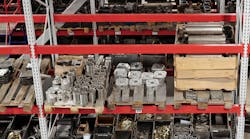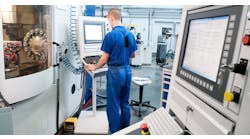Machine shops, fabricators, and other manufacturers must budget for purchasing maintenance supplies, including consumables and spare parts. These supplies are vital for implementing corrective and preventive maintenance to different production assets on the shop floor, to maximize the availability and efficiency of machine tools and auxiliary equipment.
At the same time, these manufacturers should identify possible measures to eliminate unnecessary spending on spare parts, because these are part of the usually tight annual maintenance budgets. Irrelevant expenditure on spare parts includes:
• Stockpiling - retaining excess supplies for future use;
• Holding obsolete parts;
• Purchasing non-standard parts;
• Lack of a long-term spare-part purchase plan; and,
• Unnecessary replacement of slightly damaged components.
Unnecessary spending on spare parts stretches maintenance budgets, leading to budgetary depletions before recommended timelines. This increases the quantity of deferred maintenance work due to a lack of funds to purchase required maintenance, repair, and operations (MRO) supplies. It implies that manufacturers get to deal with more frequent equipment breakdowns, inefficient assets, and unsafe facilities.
What are some strategies for eliminating unnecessary spending on spare parts?
Develop a spare-parts inventory-management system
Some manufacturers use manual methods for MRO inventory management. It is an ineffective approach that lacks consistency and is full of errors. Manufacturers using manual strategies cannot effectively track spare-parts consumption and struggle to complete periodic MRO inventory audits.
Metal manufacturers can streamline inventory management by digitizing spare-part management. Digitization means companies keep tabs on the number of spare parts in stock. The company can develop unique tagging systems for a better organization to know which spare parts are in stock, in what locations, and their purchase time. This helps those operations to avoid ordering duplicate parts or overstocking. They can identify obsolete parts and find ways to discard those parts from storage.
Digitizing inventory management allows manufacturers to integrate various systems, including computerized maintenance management systems (CMMS). The integration allows field operators to request and update inventory records remotely. And the digitized system can leverage maintenance data to create a database of frequently used spare parts. With that information, it becomes easier for manufacturers to streamline stock management and improve their control over spare-parts acquisition budgets.
Manufacturers can customize digital inventory-management systems to generate alerts when the critical stock drops beyond certain thresholds, preventing a last-minute purchasing rush or delayed acquisition of hard-to-find parts.
Perform regular spare-parts audits
Modern manufacturing operations rely on data to streamline all operations. They require data on the type and quantity of spare parts used by each piece of production equipment. They also need to determine the frequency of asset failures and replaceable parts over fixed timelines. Then, the manufacturer can compare those figures with the existing stock levels to identify how much longer they can sustain operations.
A comprehensive, data-driven audit streamlines categorization of spare parts and storage reorganization. It helps manufacturers to identify excess or unnecessary inventories – and these are spare parts that are no longer useful or in overstock. The audit also unearths discrepancies and errors in inventory records. Manufacturers learn of inefficiencies affecting spare-parts acquisition and distribution in a facility.
The audit also will allow manufacturers to explore several cost-saving opportunities when purchasing and stocking MRO supplies. This will include finding alternative suppliers, using a different vendor management strategy, or entering into framework contracts for supplying spare parts and other consumables. The audit should leverage digital tools to improve data accuracy and save time.
Streamline maintenance programs
Metal manufacturers understand the value of reliable maintenance programs. However, some are yet to streamline maintenance schedules and rely on a run-to-failure strategy. This strategy reduces equipment lifespan and increases failure rates. When equipment fails, the demand for repair parts increases. Efficient equipment runs more effectively and does not extend damage to other assets on the production line.
By streamlining maintenance programs, metal manufacturers can ensure that scheduled maintenance intervals are optimized. All production assets receive the necessary maintenance interventions to prevent premature failures. It allows maintenance teams to plan effectively and identify the exact quantity of parts required over specific timelines. Companies can improve the reliability of maintenance schedules by implementing predictive maintenance.
With predictive maintenance, manufacturers can identify and rectify underlying problems before they cause asset failures. They can avoid component replacements by fixing minor defects immediately after they occur. Manufacturers can sustain complex operations with a handful of spare parts, unlike a run-to-failure strategy, where maintenance teams deal with several uncertainties. And, they can avoid holding unnecessary spare parts and spending extra money to source rare repair components.
Repair and refurbish parts where possible
When equipment fails, some technicians rush to replace the damaged part. Some of these parts are repairable and can sustain several operating cycles without affecting the overall quality of operations. When technicians perform these replacements, they may opt for non-standard spare parts because they are cheap. Other asset failures are recurrent, and a business may prefer overstocking replacement components for such occurrences. It means they spend more money on new parts, yet the same problems persist.
Companies can save more money by repairing damaged components and refurbishing aging parts where possible. Repairs and refurbishment can extend the lives of some spare parts by a few months and reduce wastes associated with non-standard replacement parts.
Identify preferred suppliers
Working with the wrong vendor can increase an operation’s spare-parts expenditures. Some vendors have cheap methods of conducting their business, including repackaging generic parts and selling second-grade parts as originals. Other vendors take long to respond to customer requests, increasing equipment downtime or extending damage to other components.
Engaging a reliable spare-parts vendor is beneficial in several ways:
• They can assume the risks involved with storing critical spare parts;
• Long-term partnerships allow manufacturers to source spare parts at discounted rates;
• Reliable vendors can avail spare parts as and when needed; and
• They conduct quality inspections and certify products to ensure compatibility with customers’ equipment.
Machine shops, fabricators, and similar manufacturers should explore opportunities for eliminating unnecessary spending on spare parts. They should leverage digital technology to improve the accuracy of spare-parts planning, streamline inventory management, and work with reliable vendors – including approved dealerships. These companies should focus on eliminating waste in all facets of the supply chain, and complement these measures by perfecting maintenance strategies and improving reliability-centered maintenance.
Bryan Christiansen is the founder and CEO of Limble CMMS, a mobile CMMS software that helps plant managers organize, automate, and streamline maintenance operations.






